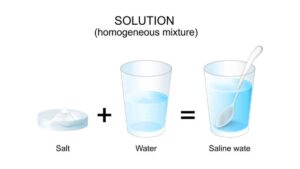The National Eligibility cum Entrance Test (NEET 2026) which is to be conducted by the National Testing Agency in May 2026, will test aspirants for their knowledge and understanding of various topics and chapters from Physics, Chemistry, and Biology subjects. One such chapter mentioned in the NEET Chemistry Syllabus 2026 is the Ionic Equilibrium; therefore, in this chapter, we have shared the NEET Notes for the Ionic Equilibrium Chapter. Scroll down in the article to find the NEET Notes along with important questions to test your understanding.
Ionic Equilibrium
Ionic equilibrium is a state of balance in a solution where the rate of ion formation from a weak electrolyte equals the rate of ion recombination. This dynamic equilibrium occurs in solutions of weak acids, bases, or sparingly soluble salts, where the concentration of ions remains constant over time. Concepts like the degree of dissociation, the common ion effect, and buffer solutions are central to understanding ionic equilibrium.
Electrolytes and Non-Electrolytes
Electrolytes are substances that dissociate into ions when dissolved in water, making the solution electrically conductive, while non-electrolytes do not form ions and their solutions do not conduct electricity. Electrolytes, like sodium and potassium, are crucial for bodily functions such as nerve signaling and muscle contractions, whereas non-electrolytes, such as sugar, are typically compounds with covalent bonds and remain as neutral molecules in solution.
| Electrolytes and Non-Electrolytes | ||
| Feature | Electrolytes | Non-Electrolytes |
| Dissociation | Dissociate into ions (charged particles) when dissolved |
Do not dissociate into ions; remain as neutral molecules
|
| Electrical Conductivity | Conduct electricity in solution |
Do not conduct electricity in solution
|
| Chemical Bonds | Primarily ionic bonds |
Primarily covalent bonds
|
| Examples | Sodium chloride (salt), potassium, calcium |
Sugar (glucose), urea, ethanol
|
| Function in Body | Maintain fluid balance, nerve function, muscle contractions, and pH levels |
Do not have a role in electrical signaling within the body
|
Degree of Ionization (α)
The degree of ionization (α) is a measure of the fraction of a substance’s molecules that have ionized into charged particles when dissolved in a solvent. It is calculated as the ratio of the number of ionized molecules to the total number of molecules initially dissolved. A high (α) indicates a strong electrolyte that mostly ionizes, while a low (α) signifies a weak electrolyte that only partially ionizes.
Factors affecting α:
- Nature of electrolyte
- Concentration of solution
- Temperature
- Common ion effect
Ostwald’s Dilution Law
Ostwald’s Dilution Law describes the relationship between the degree of dissociation α of a weak electrolyte and its concentration (C). It states that (α) is inversely proportional to the square root of the concentration, or directly proportional to the square root of the dilution, a relationship summarized by the equation
The law is based on the law of mass action and holds true for weak electrolytes, where it can be approximated for very small α and
This law helps in calculating the degree of ionization and the dissociation constant of weak electrolytes.
Buffer Solutions
A buffer solution resists changes in pH when small amounts of acid or base are added, maintaining a stable environment. It typically consists of a weak acid and its conjugate base, or a weak base and its conjugate acid. These solutions are critical for many biological and chemical processes, such as maintaining blood pH, regulating enzyme activity, and are used in industries like food preservation, drug delivery, and electroplating.
Two types of buffers:
- Acidic buffer: Maintain a pH below 7. They consist of a weak acid and a salt of that weak acid with a strong base (e.g., acetic acid and sodium acetate)
- Basic buffer: Maintain a pH above 7. They consist of a weak base and a salt of that weak base with a strong acid (e.g., ammonia and ammonium chloride)
Common Ion Effect
The common ion effect is the suppression of a weak electrolyte’s ionization by the presence of a strong electrolyte that shares a common ion. According to Le Chatelier’s principle, adding a common ion shifts the equilibrium position towards the reactants, decreasing the solubility of a sparingly soluble salt or the ionization of a weak acid or base. This effect is crucial in applications like buffer solutions, precipitation reactions, and industrial processes such as soap making and water treatment.
Example: Addition of CH₃COONa to CH₃COOH solution suppresses its ionization.
Salts and Their Ionization
Salts are electrically neutral ionic compounds formed from positively charged cations (from a base) and negatively charged anions (from an acid). When a salt dissolves in water, it undergoes ionization (or dissociation), where it breaks apart into its constituent ions, with water molecules surrounding and separating them. The overall charge of the salt is neutral, but its solution can be acidic, basic, or neutral depending on the strength of the original acid and base.
| Salts and Their Ionization | |||
| Type of Solution | Cations | Anions | pH |
| Acidic | From weak bases | From strong acids | < 7 |
| Basic | From strong bases | From weak acids | > 7 |
| Neutral | From strong bases | From strong acids | 7 |









 NEET Preparation Strategy 2026: Detailed...
NEET Preparation Strategy 2026: Detailed...
 Free NEET Sample Papers 2026 PDF | Downl...
Free NEET Sample Papers 2026 PDF | Downl...
 Salt Analysis NEET Notes, Check Importan...
Salt Analysis NEET Notes, Check Importan...









